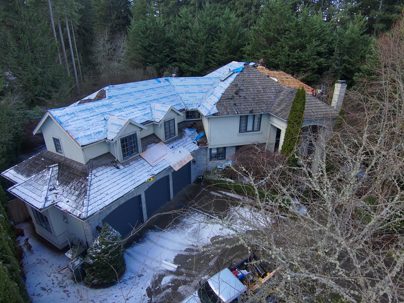Here in the Seattle area, we are rain professionals. If you’ve lived here for more than a couple years, you no longer carry an umbrella, and you can tell the difference between rain, showers, passing showers, isolated showers, scattered showers, and drizzle. We’re confident (and picky) about our rain jackets, and take to heart the Scandinavian saying, “there’s no such thing as bad weather, just bad gear.” However, we Seattleites are far less confident and prepared when the temperature drops, and the rain turns to snow. When it goes from wet to white and fluffy, panic ensues. We can’t drive, we can’t talk about anything else, and we certainly can’t function normally. With a mere rumor of snow, store shelves empty out as if the snow will cripple the area for three months, and not just two days. Even though we might not be perfectly suited for snow, our roofs must be. Snow load, and being confident your roof can handle it, is important to know before the rain transforms into white flakes.
Snow Load on a Flat Roof
Snow load, much more common and understood in snowy and mountainous climates, is an equation calculating the structure and how many feet of snow the roof on the structure, can handle. A flat roof acts as a platform for snow, and the added weight of snow on a flat roof can add strain to the framing and structure itself. The framing of the building is important, and if the framing is in jeopardy, the roof could be too. If the snow load is too much for the roof itself, and the framing that supports it, the roof is at risk of collapse. Even if it’s not at risk for collapse, it can be smart to get the snow removed from a flat roof to eliminate the risk completely. The ratings and requirements for flat roofs are different within each jurisdiction, sometimes even different from city to city. The requirements from Bellevue to Snoqualmie Pass are completely different due to the snow. If your home has a flat roof, and you need a roof replacement our Orca Roofing team will know the requirements in your area. Double checking your building department’s requirements for framing a home with flat-roofed design will help you for the future. TPO roofing, which is used on flat roofs, is a material Orca Roofing installs. Get in touch with us today for your free estimate, and to schedule your TPO roof replacement.
The Importance of Drainage
One of the most important aspects of snow load and your roof is drainage, and many factors go into having smooth drainage. These factors must be attended to way before the snow comes. Regular gutter cleaning is vital to excellent roof drainage. If your home is sheltered by many trees, multiple gutter cleanings each fall might be necessary. If gutter cleanings are too big or too dangerous of a task to manage yourself, there are many roof and gutter-cleaning companies who will do the dirty work for you. Getting the leaves, grit, and grime out of your gutters is important not only when the winter rain falls, but it’s vital in the winter when it snows. No matter the pitch of your roof, whether it’s steeply pitched and catered for the snow, or flat and collects it, clear drainage will prevent future problems. Eventually the snow will melt, and drainage—from gutters to French drains—are important parts of the system to get water away from your roof and foundation. Home maintenance, when it’s not wet and rainy, gives you peace of mind when it is.
The Danger of Ice Dams
Ice dams are the result of terrible drainage, lots of snow, and freezing temperatures. If gutters and downspouts are clogged with grit, grime or ice, when the snow begins to melt it will have no where to go. Roofs are designed for water to run downhill with the shingles overlaying each other. Water runs down, never touching the roof’s under layer. If, when the snow begins to melt, but the drainage is frozen, the water has no choice but to back up and head uphill against the grain of the roof. Water is the enemy of a roof, and when it backs up against the grain, it will most likely cause damage with an ice dam. Ice dams are preventable by manually removing the ice, and possibly the snow, from the roof and gutters. Orca Roofing proudly installs the Owen Cornings Total Protection Roofing System®, and the first layer of this system protects against ice and water. They have a number of products designed for the most vulnerable parts of a roof. The peak and valley products perfectly coincide with the multiple underlayment layers Owen Cornings offers. These layers add the first layer of defense against moisture, and seal the roof when installed. Even with these well-designed, high-quality products, they can’t prevent bad drainage, ice dams, and deferred roof maintenance.
Orca Roofing has said since the beginning that water is the roof’s greatest enemy, and because ice is a form of water, it applies here too. Water in any form—ice and snow included—can wreak havoc on a roof if your roof is old or not well maintained. Orca Roofing is a boutique roofing company with a high level of customer service, making your roof replacement about convenience for you. We stayed small on purpose in order to deliver the best products, service, and communication to you. If ice, snow or even rain, is causing problems for your roof, reach out to Orca Roofing today for a free estimate. One of our dedicated product managers will assess your roof, provide and estimate, and schedule the roof repair. When snow blankets the area it’s magical. There’s peace and quiet, new forms of beauty, but with snow load can also come unpleasant surprises, water damage, and damage to your roof. Don’t let snow load hold you back, let Orca Roofing be your go-to roofing company this winter.
The post When Rain Turns to Snow in Seattle: Snow Load and Your Roof appeared first on Orca Roofing.

